|
When I first became interested in mushrooms over 30 years ago there were two genera that very quickly aroused my
curiousity and imagination. One was the boletes and the other was the amanita's. The former having many fine edibles, amongst
them the King bolete,Boletus edulis. The latter having some of the deadliest mushrooms in North America. Over the years their allure has not
faded and I still find myself in a state of expectation whenever I venture in to the woods, hoping that I will find a species
that I haven't seen before. Because amanita's are responsible for approximately 80% of the fatalities from mushroom poisoning in North America it
follows that it is probably a good idea to be able to recognise them in the field :-) But where do we start?
The Volva.
The volva is a cup or sac around the base of the stalk and is what remains of the universal veil.The universal veil is
a membrane that envelops and protects the immature mushroom prior to eruption and elongation of the stalk and expansion
of the cap.
The three photographs (below) show Amanita virosa in various stages of eruption. From the left is the "egg" with
the volva well formed at the base and the cap as yet, still not expanded. The centre photograph shows a mature mushroom
along with an egg (for scale).On the right is shown an egg that has been cut longitudinally to show the stalk and
gills covered(almost) by the membrane.
|
| Destroying Angel, Amanita virosa. |
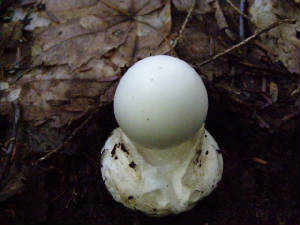
|
|
| Destroying Angel, Amanita virosa. |
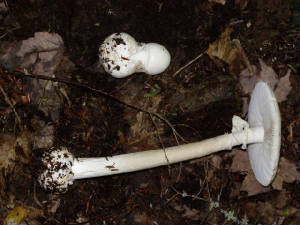
|
|
| A.virosa egg cut longitudinally. |
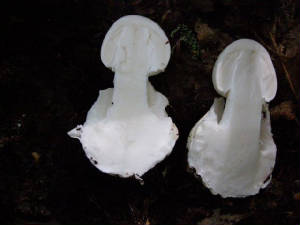
|
|
| With warts/patches. |
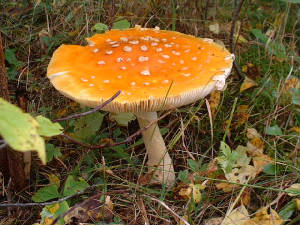
|
| Friable. |
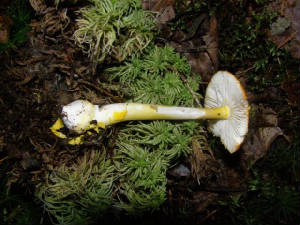
|
In some species of amanita the volva is not as well defined as with A.virosa. Depending on the species a volva may
be described as being cup like,saclike,with scales, indistinct or of a crumbly appearance(friable) see photograph above at
right. The volva is an important characteristic when trying to identify to species,see photographs below, for examples.
In addition, with some species they will also have a partial veil and this manifests itself by leaving a ring
or "annulus" at some point on the stalk,this is what's left of the membrane that covered the immature gills.As the
cap expands the membrane ruptures breaking free from the periphery(margin) of the cap and adhering to the stalk leaving
material behind in the form of a ring, as can be seen in the mature mushroom in centre photograph (above). In some amanita
parts of the universal veil are carried up on to the top of the cap and these deposits can variously be described as warts
or patches,see photograph above at left. These deposits are also helpful in determining to species, unfortunately they
are easily removeable and are often washed off by rain.
|
| Saclike. |
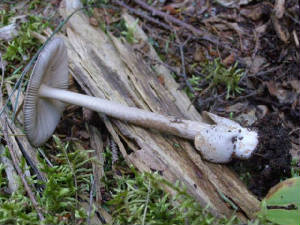
|
|
| Indistinct. |
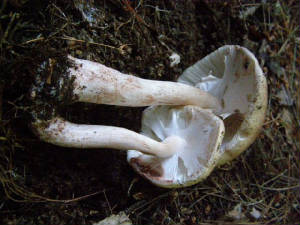
|
|
|
| Cuplike. |
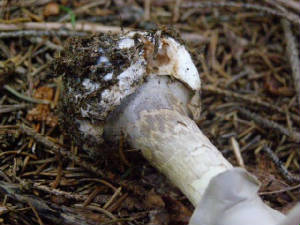
|
|
| Scaly. |
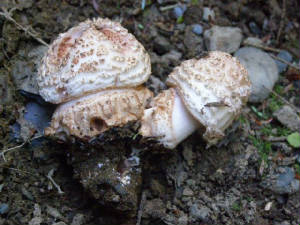
|
|
| Striations. |
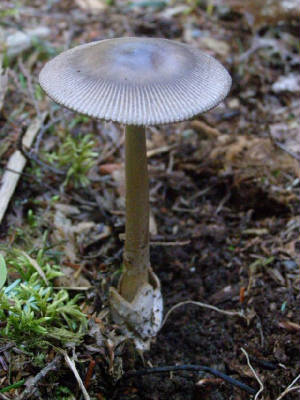
|
| Appendiculate,not easy to see on this photo. |
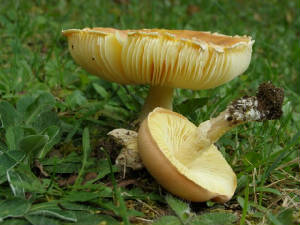
|
The cap.
All mushrooms are subject to the elements and this can effect the colouring of the mushroom,particularly the cap(pileus).Be
aware that there will be some variability when attempting to identify to species. In almost all cases the gills will be free
of the stalk, but there are exceptions. As previously noted elsewhere on this page patches or warts on the cap may
help identify to species. Also of importance is whether the cap has striations or whether it has remnants of the partial veil(appendiculate)
hanging from the margin. Striations are radial lines,much the same as the spokes of a bycycle that radiate from the margin
and go some way towards the centre of the cap.In my experience mushrooms with striations are much more common than mushrooms
that have remnants of the partial veil hanging from the margin.Mushrooms that I have found that have striations on the cap
are; A.muscaria,A.ceciliae,A.vaginata and A.fulva. On the other hand finding mushrooms with appendiculate on the margin is
much more difficult. The only one I have ever found was in September of 2007,Amanita wellsii. This mushroom is a rare
find in Nova Scotia.
To my knowledge there are three other mushrooms in Nova Scotia that leave remnants of the partial veil on the margin
they are; A.atkinsoniana,A.chlorinosma and A.onusta. I have not seen any of these three in Nova Scotia so my assumption is
that they must be very rare. If you find any of these three I would be very interested to hear about your find.
Spore print.
The spore print of all amanita's is cream to white.The gills will also be of a similar colour.
Amanita's known to grow in Nova Scotia.
Below is a list of Amanita's that are known to grow in Nova Scotia. There may be many more that have yet to be found
and documented. If you should find one that isn't on the list I would be interested to learn about it.
|




